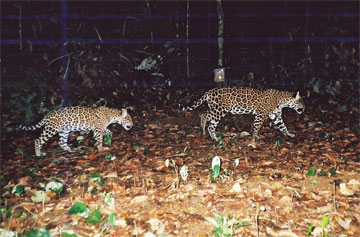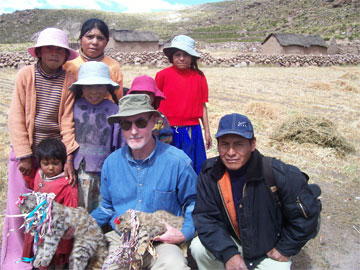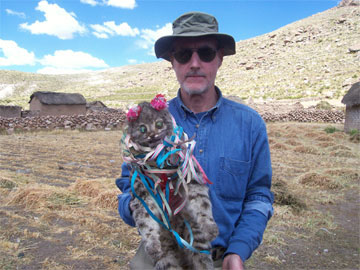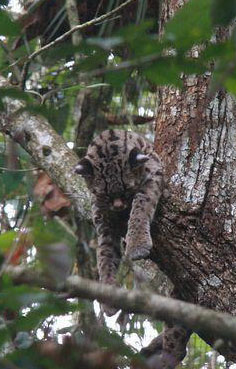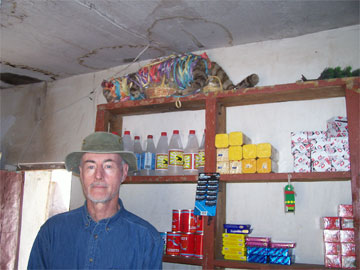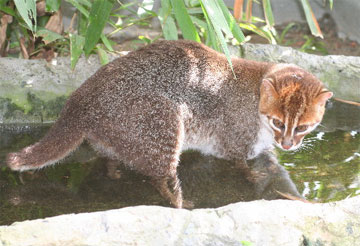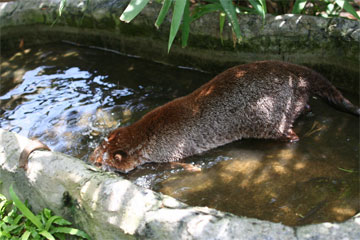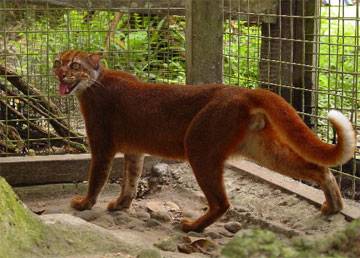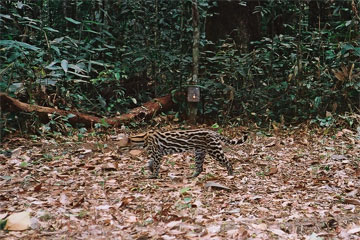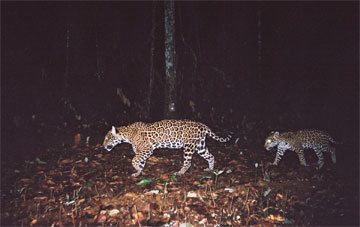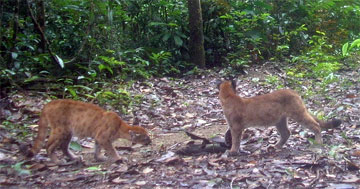Often overlooked, small wild cats are important and in trouble
Often overlooked, small wild cats are important and in trouble:
An interview with small cat specialist Dr. Jim Sanderson
Rhett A. Butler, mongabay.com
August 5, 2008
|
|
While often over-shadowed by their larger and better-known relatives like lions, tigers, leopards, and jaguars, small cats are important indicators of the health of an ecosystem, says a leading small cat expert who uses camera traps extensively to document and monitor mammals in the wild.
Dr Jim Sanderson, a scientist with the Small Cat Conservation Alliance and Conservation International, is working to save some of the world’s rarest cats, including the Andean cat and Guigna of South America and the bay, flat-headed, and marbled cats of Southeast Asia. In the process Sanderson has captured on film some of the planet’s least seen animals, including some species that have never before been photographed. He has also found that despite widespread criticism, some corporate entities are effectively protecting remote wilderness areas. He cites BHP Billiton’s bauxite project in the Bakhuys mountains of Suriname as an example.
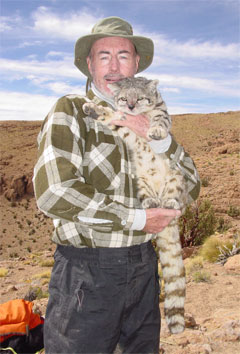 Jim Sanderson with a live Andean cat in Bolivia. Photo by Lillian Villalba. |
“If run properly, these sites can be better protected than a national park because in a national park the public is allowed. In these areas no one is allowed except the workers and their behavior is tightly controlled and monitored,” he explained. “So it is pretty easy for me to see a partnership between industry and the conservationists… In addition, they have money to support research projects.”
Sanderson has set up a large-scale camera-trapping project that will monitor the impact of bauxite extraction in BHP Billiton’s 240,000-hectare concession. Although mining will be limited to a couple thousand hectares in the concession, Sanderson will use an extensive collection of images as a baseline to determine how wildlife is affected by the mining activities. The camera trapping has already provided Sanderson with insight on the behavior of resident animal species, including predator-prey relationships, wildlife densities, and mating and reproductive habits.
“We have pictures of jaguars carrying armadillos in their mouths, and we have a picture of a puma wrestling a red brocket deer to the ground. So, we get some indication of what these predators are eating,” he told mongabay.com. “But we also get mating behavior. We have repeated pictures of jaguars copulating right in front of the camera traps. All of these mating-jaguar pictures are taken in May and June, which turns out to be near the end of the long rainy season. So we suspect that it’s not true that these animals breed all year long, but in fact they breed at a certain time of year in response to rainfall, and have their young several months later during the dry season.”
Sanderson discussed his success with camera trapping (including his preference for film over digital cameras), the efforts to save wild cat species through the Small Cat Conservation Alliance, and small cat behavior in an interview conducted with mongabay.com in Paramaribo, the capital city of Suriname.
How you can help
When asked how people can help small cat conservation efforts, Sanderson said that small cats are typically overlooked by zoos. By simply asking to see small cats when you visit a zoo, it could help redirect emphasis and possibly conservation funding towards saving small cats in the wild.
“Most American Zoological Association (AZA) zoos do not exhibit small cats because they do not believe the public wants to see them. They instead exhibit the large and charismatic small cats,” he said. “When you visit a zoo ask to see something unusual — the small wild cats.”
Donations help too: Wildlife Conservation Network
AN INTERVIEW WITH DR. JIM SANDERSON
Mongabay: What is your background and what sort of work do you do on small cats?
|
|
Jim Sanderson: I have a PhD in mathematics and was a practicing mathematician for 20 years. I decided to reeducate myself and because I became interested in small cat conservation. I went back to school, got a degree in biology and then started my PhD in wildlife ecology and conservation at the University of Florida. I actually never received my PhD because my professor said I already had a PhD and had already published enough papers. While I was there I co-authored two books with my professor. One is in its second edition and we are working on the third edition. Since they basically kicked me out of the PhD program prematurely, I went to work with Conservation International.
I had been doing my PhD on the Guigna, which is a small forest cat in the south of Chile that had never been studied before. All we had to go on was one picture of one living individual. The total extent of our knowledge of this cat was that picture and some stomach content of museum specimens, the last of which had been collected in 1919. Given these circumstances, people were very discouraging and funding was almost non-existent, but nevertheless I took a crack at it.
In 1997 I was able to catch one and demonstrate we knew where they were. A year later I went back and caught eight in thirteen days and put radio collars on them. This was the first study ever of the Guigna.
|
|
That same year, I went looking for the Andean cat, which is the most endangered cat in the Americas. The Andean cat had been photographed twice: once by a professional photographer and once by a tourist from New Zealand who was traveling in the high Andes. So to start, I had a picture of an Andean cat taken next to an orange pole. All I knew was that it was from the north of Chile. Once again people told me I was crazy, that I would never find this cat, that I would waste a lot of time and money looking for it. But in fact after about six weeks I got my first sighting of the cat and when I approached to see it more closely, it came down to see me more closely. So at 4300 meters (14,100 feet) I began my pursuit of a cat that was just as curious about me as I was of it.
The photographs appeared in the National Geographic in February of 2000. Based on those photographs we were able to start a full conservation program in all four range countries that was funded by the Wildlife Conservation Network. I am now a partner, one of the eight partners, of the Wildlife Conservation Network (wildnet.org). Our Andean cat project is still running there; it’s a very successful project.
|
I have been working in Borneo, China, and Sumatra. In China we went after something called the Chinese mountain cat. Now this is the cat that was described in 1892 by a Frenchman at the Paris museum. The skins were purchased during an expedition to China around 1890 and brought back to the Paris museum where they were identified by a French mammologist as a species of cat unknown to science. It was the last new cat to be described.
When we started, we didn’t know where to look. We didn’t know its habitat and it had never been photographed in the wild. Over the course of a four year period I went back and forth to China to try to find where this cat lived. Eventually I came to one village where the Tibetans were wearing hats made out of this cat so I knew it was up in the Tibetan plateau somewhere. I gave numerous talks about my search for this cat and one young Tibetan man said, ‘I’ve seen this cat. I remember when I was a child my father had skins of this cat. I am certain that this cat lives around my village.’ He said that it lived on the eastern side of Tibet, on the escarpment next to Szechwan. ‘We have to go to my village.’ So we got on a bus. It was about an eleven-hour bus ride through the mountains of China. We arrived at his village and people had the cat skins. Nearly every house we knocked on showed the skin of the Chinese mountain cat. It was the Holy Grail. So at this point we were able to put out our camera traps, we knew where to look. The three of us, my Chinese student, a Tibetan, and I rode on a motorcycle and then walked up into the hills. We placed our camera traps and got the first pictures ever of the Chinese mountain cat.
Carlos Driscoll later classified the cat as a sub-species of Felis silvestris. Therefore it is no longer considered the last cat ever to be described. That distinction now goes to the Bay cat. The second to last is the Andean cat.
In Bolivia, Lillian Villalba, Constanza Napolitano, and I were able to capture an Andean cat at an elevation of 5,400-5,500 meters and put a radio collar on it. Now 5,400 meters (17,700 feet) is higher than any point in the continental U.S. This is truly the snow leopard of the Andes. Or maybe I should say the snow leopard is the Andean cat of the Himalayas. But this is the most endangered cat in the Americas and the reason is it doesn’t show any fear of people. The Chinese mountain cat is afraid of people. It has been hunted to make accessories like hats, although this practice has now stopped because of the announcement of the Dali Lama to Tibetans to stop killing these cats, at least in the village where we were.
|
|
But with the Andean cat shows no fear of people and in the high Andes, the people attribute supernatural powers to the cat. These powers can be harnessed only if the cats are dead. So they kill the cats, typically by dropping a rock on them. Or as some people have described to us, they run up to the cat, throw their coats over it and then kill it. I have many pictures of Andean cats in small villages—far more than are in museums around the world, there is one specimen in the US—of people with these dead, stuffed Andean cats in their shops as good luck charms. Native Americans adorn them with silver coins and wool and carry them around as sacred objects. These charms are called titi and are not sold. They are considered sacred and are passed down through the family. The Andeans are always wanting more but these are very rare cats. So we have a conservation dilemma in that we are trying to save a cat that shows no fear of people but is coveted as a sacred object. This is a difficult problem to handle, particularly when the park guards are Native American and they stone the cat if they find it.
I’m now working on the flat-headed cat and the Bay cat from Southeast Asia. Both are endangered.
Mongabay: Why did you decide to study small cats?
Jim Sanderson: I found back in the early 80s that all of the big cats had really been studied, but all of the small cats, which are the majority of cats, had never been studied. I could open up a book on wild cats and it would say nothing is known. We know only that it exists. We don’t know what it eats. We don’t know when it’s active. We’re not sure of its distribution. So, the small cats were largely unknown and no one was working on them. All the big cats — tigers, lions, pumas, jaguars, leopards, cheetahs — had lots of studies. But the small cats, it was as if they were just left for me to do.
Mongabay: You have some pretty amazing experiences, as far as being able to find and also catch some of the world’s rarest small cats. What’s the secret to catching small cats?
Jim Sanderson: You have to have several things. You have to have a passion what you are doing. Without passion you’re not going to be successful, because it is not easy. The second quality you have to have is patience. It turns out I have a lot of patience for these small cats, and I am willing to wait them out because I know that I’ll eventually find them. Whereas I don’t have a lot of patience when I deal with people, I have a lot more patience with animals. So I would say passion and patience is what it takes. Persistence is important too. You have to keep going when it looks like you’re never going to find anything; you have to keep looking, because it’s then that the animals are telling you something that you don’t know. You learn the most when you can’t find them for a long time. When you find them right away you don’t learn as much.
Mongabay: So on that note, is there anything you can learn about the greater ecology of an ecosystem from the presence or absence of these small predators.
|
|
Jim Sanderson: These small predators occupy a wide variety of habitat. There’s no arboreal canine (dog) but there are arboreal cats—cats that live mostly in trees. So as a result we have a lot more cat species than we can have dog species. Cats show greater variation in body weight — there’s no dog as big as a tiger — and they use space more efficiently. Some having these small cats in an ecosystem can tell you a lot.
For instance, one of the cats we were studying is the margay in Brazil. We found it during the day looking around in the tops of trees during the day. What was is doing? It couldn’t catch birds during the day, because birds you know can out-compete a cat in the tops of the trees. But it turns out the cat was eating bats. It was looking for bats that were roosting in the trees. So, that tells us a lot about the environment. When they are active during the night, they are out hunting rodents. When they are active during the day, they’re hunting something else. They tell us with their very presence that there is a lot of prey out there. The health of the ecosystem can be determined by top predators, because their presence tells us that there is adequate prey for them.
Mongabay: Let’s look at the human element in this picture. With the caveat that threats to cats are highly variable depending on where they are, what are some of the greatest dangers to small cats?
Jim Sanderson: Of course some of the cats share similar threats — like habitat destruction, loss of prey, and hunting — but they also face widely variable threats in some cases.
|
|
The Andean cat faces three principle threats. Number one, it shows no fear of people. So, that’s a problem when local people attribute supernatural powers to the cat and kill it (number two). Number three, the locals eat the same prey that the cat does, the small mountain vizcacha that look like rabbits. So, how do we deal with these threats? Well, the people have been hunting vizcachas for thousands of years, so it’s unlikely they are going to change their behavior just because we tell them the cat needs to be conserved. What about teaching these cats to be afraid of people? Well, I have seen four in my life, and that’s two more than anybody else that we know about. Of the 45 people involved in this project across the full cat range—Peru, Argentina, Chile, and Bolivia—only 6 have seen an Andean cat alive and they have been working on this project for four years. So, it’s not like you see this thing everyday. But that’s the threat that we have with the Andean cat, we are dealing with some very thorny issues here. People eat the same food and then they kill the cat when they see it. They chase after the cat, throw there coat over it and they just kill. So that would be a more or less direct threat from humans.
On the other hand, a small cat called the flat-headed cat, faces the exact opposite kind of threat. It’s does compete with people for food. It doesn’t eat chickens. It is a lowland specialist that eats only fish and frogs and is about the size of a small house cat. It lives in the swampy wetlands of Malaysia, Sumatra, and Borneo. But here the threat is palm oil plantations — the unmitigated conversion and total loss of habitat driven by oil palm plantations. Without regard to any of the wildlife, all the trees are cut down and then palm oil trees are planted. And it is unmitigated, that is, there is nothing set aside to compensate for the loss of the land. Here the cat just loses its habitat without anybody caring about what happens. This is the biggest threat in South Asia is the replacement of habitat by oil palm. You can drive for hours at a time—five hours—and see nothing but oil palm.
Mongabay: Does anyone know the habitat requirements of the flat-headed cat? If you were to preserve riparian zones within oil palm plantations, would that be enough for it?
Jim Sanderson: Well that is a good question—we don’t really know. But generally there are three animals in oil palm plantations: there are rats, palm civets, and leopard cats that eat the rats. That’s about it.
They are not wealthy in terms of biodiversity. I don’t think preserving a riparian area in the oil palm would work and the reason is that the pesticide use and what goes into those streams would just clean out the fish and the frogs. But we don’t really know because nobody has ever studied the flat-headed cat.
We do know that the flat-headed cat is the most aquatic of the cats. It puts its head under water and looks for fish. When is sees prey, it goes right into the water. It typically fishes along the river banks.
|
|
Let me give you an example of how rare it is. If you put a camera trap out in the mountains of Sumatra you will record all five cats: tiger, clouded leopard, marbled cat, golden cat, and leopard cats. If you put your camera traps out in the lowlands, you are very unlikely to get a flat-headed cat or a fishing cat. I know of only one fishing cat camera trap picture in hundreds of thousands of camera trap pictures taken in Sumatra and I only know of three flat-headed cat pictures. These are extremely rare cats. The reason is the fishing cat and the flat-headed cat are both fish specialists and tied to water and the lowlands of Sumatra are being converted into oil palm plantations. So these small cats are in big trouble. We say that the big cats act as an umbrella species, that means that if we protect the tigers habitat and we work on the tiger and conserve tigers that they will serve as an umbrella species to protect the habitat that they live in. But the tigers are able to live in fairly high-density human situations. In India these parks are surrounded by people and we still have tigers. But when it comes to small cats, we are looking for them and we can’t find them. Are they really under the wing of the protected species or have they disappeared? We don’t know.
Mongabay: What can people do at home to help protect their small cats or wild cats?
Jim Sanderson: A more environmentally-friendly palm oil industry would be a great start. That would go a long way towards helping the cats of Southeast Asia which is, by the way, is a hot spot for conservation activity right now. Working in South America is a paradise compared to working in Southeast Asia.
Increasing your awareness of these small cats is also important.
Mongabay: What about your organization — smallcats.org?
|
|
Jim Sanderson: The site is a good way to learn what we’re working on. A lot of focus has always been on the most endangered ones. My priorities are covered by the red list –these are always the rarest and least known ones: the Andean cat; the flat-headed cat; the bay cat which is endemic to Borneo; and the Guigna. My priority has always been the rarest ones and the ones that have largely been ignored.
Most American Zoological Association (AZA) zoos do not exhibit small cats because they do not believe the public wants to see them. They instead exhibit the large and charismatic small cats.
When you visit a zoo ask to see something unusual — the small wld cats. Conservation efforts for small cats do not cost nearly as much money as do big cat efforts. We learned to achieve a lot for a little. Any contribution helps. See the WCN website to help out the small cats with a tax free donation.
Mongabay: What about the Tibetan Cat?
Jim Sanderson: Very little was known about the Chinese Mountain. The habitat was not surveyed and we didn’t have any pictures of it in the wild. So when we set out to learn more about them, it was really hard to find information. After a long time we finally got on the trail. We finally were able to get pictures of it.
What was the threat to the Chinese Mountain Cat? People where making accoutrements from the cat skins. They would kill the cat and make a hat out of it or sell it to the Chinese Muslim traders. They’re the ones that have the shops that sell all the animal skins.
So that was the threat — direct killing. There is no other threat; the habitat is so huge that in the Tibetan plateau that habitat loss is not a threat. It is mostly used for grazing. But you have semi-nomadic herders who can’t read or write and don’t have a whole lot to do during the day when their livestock grazing. When they see that cats they catch them and skin them out.
One person eliminated that threat across all Tibet — the Dali Lama. When he said, “I am tired of my people killing animals and wearing animal skins” people across all Tibet listened and stopped killing the cats and everything else as far as we can tell. I wish I had that kind of pull.
This was just part of a longer statement that involved other issues, but of course this is a very political issue. So of course when the Tibetans started burning the skins the Chinese cracked down on them for political actions — following the word of the Dali Lama. Even though it was a positive thing for conservation, it was a very politically charged time because people were listening to the Dali Lama.
Mongabay: Is domestication or keeping wild cats as pets much of a problem anywhere?
Jim Sanderson: It is not a common thing that you see these cats as pets — they don’t make good pets. People put out food for Guignas sometimes, so the cats will come to get food but they don’t come indoors of course. They shy away from people. But generally speaking I don’t see that this is a big problem. In response to wildlife laws and state laws people are trying to cross wild cats with domestic cats to create crosses so they will have a more exotic house cats but usually they escape, of course.
Mongabay: What are some other small cats that are at risk?
Jim Sanderson: I am on the IUCN cat specialist group as a voting member. I see myself as representing the small cats and offsetting many of the other members who are large cat specialists and are well-represented on our group. Of course we are all colleagues and we all help each other, but when there are small cat questions, they look to me.
On the opposite end from the forest cats is the sand cat, a desert specialist. It is a little cat which lives in the northern Sahara desert and in the Middle East. It feeds on rodents and lives in burrows excavated by other animals because cats are not excavators. This is another cat that lacks real analysis. We don’t know what is happening to it. It is slipping through the cracks. I think there is one study on it now in Saudi Arabia.
The black-footed cat is found in South Africa. It is so small it called the anthill tiger. It is a cat half the size of your house cat but it stands on the top of ant hills and screams.
The marbled cat is another cat from Southeast Asia and south Asia. We believe is an arboreal specialist because of its big tail. It is much rarer than a clouded leopard, which we know a little bit about thanks to the work of Andy Hearn and Jo Ross in Danum Valley [An interview with Andrew and Jo in Borneo].
I have good people working on all of these now. Those are the people that are really doing the real work. I am just their assistant now.
Mongabay: It sounds like you have had some positive experiences working with industry in conservation efforts. Can you talk about the role that industry can play in protecting important wildlife areas.
Jim Sanderson: Yes, definitely. Right now I’m working at BHP Billiton’s bauxite mine site in the Bakhuys mountains. They are going to remove the tops of mountains to get to the bauxite, which is used in the production of aluminum, but it is a long-range project: twenty-five years at a single site of a couple of thousand hectares. Their concession covers around 240,000 hectares and they control access to the whole area. No one goes in or out the gate and into this huge area without their permission. Workers are prohibited from hunting or harming wildlife in any way. This means the animals there are very well protected.
It was a similar case at Collahuasi mine in Chile. This is one of the largest open-pit copper mines in the world but the wildlife was again protected because the workers’ behavior at the site was very tightly controlled. They were either living at the hotel or bused back and forth from the mine site and there was a gate to get in. So you couldn’t access the site unless they wanted you to get in and they restricted access to the public. So these mines that I’ve seen can be particularly good stewards.
I always tell people that if run properly, these sites can be better protected than a national park because in a national park the public is allowed. In these areas no one is allowed except the workers and their behavior is tightly controlled and monitored. So it is pretty easy for me to see a partnership between industry and the conservationists. I think it’s great. In addition, they have money to support research projects. So if people are interested in studying the wildlife or monitoring the wildlife, oftentimes they are more than happy to provide funding for that because they like to see people out walking around on their land where they are doing work and writing about it.
Mongabay: Do the results of research impact whether a company develops an area of not?
Jim Sanderson: Absolutely. In the case of Suriname, when researchers found a small fish that was endemic to a small stream, the mining company said, “Well, we will leave the bauxite in the ground. We are not interested in mining there.” A finding like this gives conservationists the upper hand.
Mongabay: What about when the miners leave? These are long-term projects but someday these companies are going to pull out when they’ve extracted all the minerals. So then is there kind of a risk that these roads will then serve as conduits for development, like logging or things of that nature. Do you have any thoughts on that?
Jim Sanderson: That can happen, but we have plenty of time to act in between since these are long-term projects. First of all the companies have to repair the damage that they do. When they remove the top soil and the plants and trees, they have people there who document everything so they area can be restored as well as possible. The plants are put in greenhouses while mining is being conducted.
In the Bakhuys, BHP Billiton is already looking for another company to handle the restoration even though they haven’t started operations. They will be able to restore some of the sites where they did the exploration. In the 20-40 year interim before they leave the site we hope education can kick in and start to change the perception wildlife is only food for the pot or to sell, particularly to foreign workers. We’ve got time to look into the future and say, “We had better start teaching wildlife classes in schools to educate people.”
|
|
Hopefully the standard of living in the country will increase during that time as well. As standards of living rise, the need to hunt declines. In developed countries most people who hunt do so recreationally. In poor countries people need to hunt for food or to sell meat to the market. They don’t have licenses, they do have hunting seasons but nobody obeys them. In the US you can go to the store and buy beef cheaper than you can go out and hunt a deer, although this wasn’t the case in the early 1900s when the total deer population was estimated to be less than 100,000 animals. That is about the time we started getting conservation rules put into place during Theodore Roosevelt’s presidency. So we went through a period in the US where we nearly eliminated all of our wildlife and it seems like other countries are learning the lesson that we learned.
Mongabay: Getting back a little bit to the mining, how does damage from bauxite mining compare to damage from gold mining? It seems that mercury is a big problem with small-scale gold mining here in Suriname.
Jim Sanderson: It doesn’t have to be that these mines are so dangerous. It is just the attitude of the company whether they are going to be responsible for the damage that they do. All mining causes damage. In bauxite mining they have to remove the forest and the soil to get to the bauxite deposits so it is incredibly damaging.
It depends on how the company operates; whether they want to be good stewards of the environment or whether they don’t care. Now often times the rules of the country are so loose that the companies are able to be whatever they want. It is only a company that shows responsibility that says, “We are going to work in accordance with rules that are stressed by the World Bank and not the countries themselves because their rules are too weak.”
Mongabay: Let’s look at your current work in the Bakhuys. Are you establishing a baseline to see how mining affects the wildlife and the forest?
Jim Sanderson: I am working at the Bakhuys mountains, which are west of the Central Suriname Nature Reserve. This is an area that as far as we can tell has not seen people for at least 50 years. No one lives near it and no one lives in it. There are two small tourist operations near by, but that is it. BHP Billiton has been exploring for bauxite deposits there for about four years and in order to do that exploration they put in some dirt roads. The whole area is about 520,000 acres. The bauxite deposits are relatively localized on the tops of mountains. They are interested the highest grade ore deposits and these are few and far between. These deposits are only several thousand acres each and there are less than eight. They are also interested in exploring other parts but they haven’t done that yet. They will probably do that in the future.
What I wanted to do was establish a baseline of what was there as part of the environmental impact statement. Three years ago I started working on the environmental assessment of the area; focusing on the large mammals. I decided to use camera traps as part of the effort to establish a baseline of what lives in the forest.
The camera traps revealed the richness of the area. The pictures started circulating around the company and they asked me if I would continue with the monitoring project to see what kind of an impact the mining was having. They wanted to see if we could turn the monitoring into a way to mitigate the impact of mountain top removal on the large mammals. So we kept on camera trapping and established a disturbance gradient to measure how mining activities would affect wildlife.
|
|
We have been doing this now for three years and still have another two years before mining is expected to begin. So we will have five years of baseline data before the mine ever gets really going. The trapping has revealed a lot about the animals and we know that if we keep running the camera traps we will eventually get pictures of all the species. Establishing the gradient before the mining starts allows us to understand the background and what factors — like rainfall and temperature — affect the background. It turns out that after three years we can pretty much say that there is no difference between any of the sites. It’s true that only one or two sites show the very rare animals, but more common animals such as jaguar or pumas show up at every site — we don’t have a single site that doesn’t have jaguars or pumas. Once mining does we will be able to measure the impact on wildlife.
Mongabay: Expanding on camera trapping in general, because you have an amazing amount of data, but if you could explain what you can learn from camera trapping as far as activity times and predator-prey relationships?
Jim Sanderson: One of more obvious that we get from camera trapping is activity patterns. We can look at the time the picture was taking and plot the number of pictures that were taken each hour. If a species is taken more than one time in an hour we only count that as one picture for that for that species for each camera trap. In other words, if an animal sits in front of the camera trap for ten minutes we don’t want to count ten pictures, we just want to count one picture. So we get at most one picture per hour per species per camera, and we make a plot of this.
If an animal is active just during the day then we will only get pictures during the day and we won’t get any at night. This makes it possible to establish an activity pattern for each animal. For instance from 800 pictures of tapir we know that tapir are mostly active at night.
This is one of the obvious pieces of information that we can get from camera trapping. When mining starts we will be able to see if the animal’s activity pattern change.
Another piece of information that we can get is the distribution of animals. If you work with camera traps long enough you should be able to say ‘this camera has a lot more picture than this camera and there must be a reason for it’. As it turns out we don’t see much of a difference across any of our sites.
|
|
Another valuable piece of information is density, the number of individuals in the area. To determine this we need to have two opposing camera traps at each site and when the animal walks between the cameras, the camera takes a picture of both sides of the animal. For animals that are laterally asymmetric, like the jaguar which has different patterns on each side of its body, we can distinguish between individuals and can determine how many jaguar are using our study area. With the proper assumptions, we can calculate how many individuals are in a particular area and determine the number of females and the number of male. It turns out that these jaguars are occurring at multiple sites, so they are roaming around — both the males and females.
When you put all this together, there are a couple pieces of information that can be used to monitor the impact of mining.
Mongabay: You’ve also captured some interesting behavior on camera.
Jim Sanderson: Thank you for reminding me. Of course, the camera captures also their behavior: we have pictures of jaguars carrying armadillos in their mouths, and we have a picture of a puma wrestling a red brocket deer to the ground. So, we get some indication of what these predators are eating. But we also get mating behavior. We have repeated pictures of jaguars copulating right in front of the camera traps. All of these mating-jaguar pictures are taken in May and June, which turns out to be near the end of the long rainy season. So we suspect that it’s not true that these animals breed all year long, but in fact they breed at a certain time of year in response to rainfall, and have their young several months later during the dry season. They leave their parents in about a year, because we see the young in the camera traps following the mother around, and in about a year we see the young on their own in the camera traps. So, we are getting a little bit of a family history among the jaguars. But definitely they are not breeding all year long as near as we can tell.
Mongabay: Do you have any thoughts on digital versus film, what do you prefer for camera trapping?
Jim Sanderson: One of the things first that I would like to stress is that anybody, probably even a chimpanzee, can put a camera on a tree. That’s not what I do; that’s not my job. My job is to put the animal in front of the camera. So, that’s a different task than putting a camera on a tree, and it involves many considerations.
As for using digital cameras versus film cameras: I prefer film cameras. Now most people want instant gratification, so they want to walk out to the camera, turn it on, and see what they have. I prefer film cameras because they are faster.
The latency time is the time between the sensor recognizing something has walked in front of it and the camera takes a picture. For a film camera the latency time is about half a second, certainly, at most, less than a second; whereas in digital cameras it’s about two-and-a-half seconds. So with digital cameras, if you’re not careful you can get a lot of pictures of “headless jaguars” or just the rear of animals, because of the delay after they walk in front of the camera sensor. The digital camera has to wake-up, turn on, and then it snaps the picture. With the film camera’s latency time of less than a second, you get a picture right off the bat, as soon as the sensor picks it up, and it always appears that the animal is right in front of the camera. But of course the instant gratification is not there — you have to wait to develop the film. There are pros and cons.
Digital cameras suffer a little bit less from moisture damage. Power requirements are higher for digital cameras than they are for film cameras but the digital cameras can hold a lot more pictures than film cameras, because a film roll is thirty-six pictures. In our test site we can go through thirty-six pictures in a week; we have to check film cameras more often than digital cameras. They cost about the same as a high quality camera but that comparison is deceiving. The question that most troubles me is when someone says ‘well, I compared these cameras and one is cheaper than the other’. People should know that with camera traps you get what you paid for. If the objective is to save money than don’t buy a camera trap at all, because they are very expensive. If the objective is to get lots of pictures then I suggest that people buy a good camera. The metric is the not the number of pictures but the number of useable pictures. If you want the cheapest camera, then that’s a different metric.
Dr. Jim Sanderson is involved with the Wildlife Conservation Network, the Small Cat Conservation Alliance, IUCN Cat Specialist Group, the Small Wild Cat Endowment Fund, and the Feline Conservation Federation.
Special thanks to Tiffany Roufs for her help transcribing the interview.
